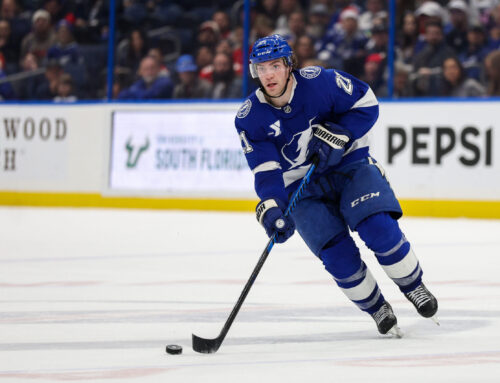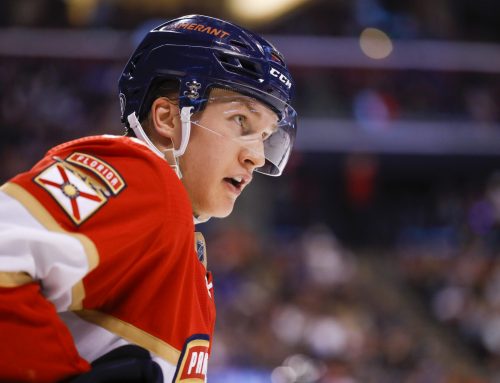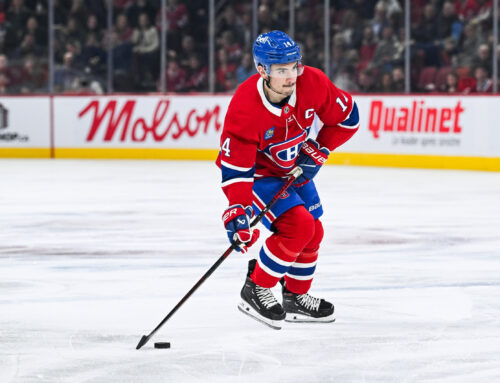Welcome back to Goldipucks and the Three Skaters, a play on words of the Goldilocks and the Three Bears story. Here though, instead of there being three bowls of porridge, normally I cover three skaters and declare one too hot (i.e., doing unsustainably better than he should), another too cold (i.e., doing unsustainably worse), and a third “just right” (i.e., producing where he should be). In addition, I normally also assign each a rating of 1-10, indicating just how hot (rated 7-10, where 10 is the most unsustainably hot), or how cold (rated 1-4, where 1 is the most unsustainably cold), or how “just right” (rated 4-7, where 5.5 is the most “just right”) he is.
Why did I add the word "normally" twice above? That's because today's column won't be a normal Goldipucks. The issue is we're only a few weeks into the season, and either it's very apparent who is too hot (e.g., Joe Pavelski, James van Riemsdyk, Jeff Petry), too cold (e.g., Evgeni Malkin, Mika Zibanejad, Roman Josi) or just right (e.g., Kyle Connor, Ryan O'Reilly, Brayden Point), or there isn't enough data to confidently make that type of evaluation. So instead of covering three players as I usually would, I'll go over the various metrics I use to determine if a player is too hot, too cold, or just right. With this information, you can make assessments on your own, although even after you're armed with my "secrets" I hope you'll continue to keep reading this column once it's back to business as usual.
Ice Time
Although there always can be outliers, ice time strongly correlates with scoring, especially for forwards. In the prior five seasons, there were 89 instances of forwards who played in 40+ games and averaged a point per game or higher. Of the 89, only two averaged less than 18:00 per game when doing so; and if we raise the threshold to 18:30 per game, we get only six more players. Even if we go by 0.75 points per game rate, translating to just over a 60 point full season scoring pace, the number of instances within the same time frame spikes to 308, but ice time remains key, as only 22 of those 308 averaged less than 17:00 per game.
This is important because some teams (e.g., Anaheim, Arizona, Montreal, Ottawa), don't lean on their top lines/players as much as others; so if a team's forward leader in TOI is getting around 18:00-18:30 per game and scoring at a 90 point pace, he's almost assuredly too hot. Not all ice time is created equal too, as factors such as a player's offensive zone starting percentage – discussed below – and quality of linemates also matter.
Power play minutes are paramount for all skaters. Because teams have different rates of drawing penalties, one has to examine not just a skater's PP time, but what percentage of his team's man-advantage minutes it represents. This is important early in the season, as more penalties often get called during the first quarter versus the second, etc. Here too it matters what team one is on, as some (e.g. Boston, Edmonton, Chicago, Florida, Vancouver) have forwards seen upwards of 75% of its PP time, whereas on others (e.g., Anaheim, Arizona, and Montreal again, plus Carolina, Columbus, Detroit, Nashville, New Jersey, Philly, Vegas, San Jose, St. Louis) no forward skates for even 60% of his team's PP minutes.
Also important is what a player does with his PP time. If his man-advantage minutes rank him, let's say, 24th among forwards in PP time per game, but he stands only 79th in PP scoring, then either he's due for more PP points or his PP spot could be in jeopardy. On the flip side, a player who ranks much better in PP scoring than PP time per game is likely to receive even more PP time and, with that, tally more PPPts.
When looking at well-performing players, it's important to see if they might have realistic room for still more ice time (e.g., Nicolaj Ehlers, Jonathan Huberdeau, William Nylander), or, in contrast, if they're already maxed out (Mitch Marner, Mark Scheifele, Anze Kopitar) Here too the team's ice time philosophy has to be factored in, as the best of the best on certain teams see several minutes more ice time than their counterparts on other squads.
SHOTS ON GOAL
Like ice time, high shot totals and high scoring tend to go hand-in-hand. There are some exceptions, however, like pass-first centers (e.g., Joe Thornton, Henrik Sedin and Nicklas Backstrom), who can pile on points despite meager shot totals. On the flip side, quite a few players (think Evander Kane, Jeff Skinner, Brendan Gallagher, Craig Smith) put up sky-high SOG totals without becoming elite scorers. For most players though, SOG totals are strongly associated with scoring, so it's crucial to see when SOG and point totals do not correlate and determine if that might be why a player is too hot or too cold.
Shooting percentage is also key, but it can't be looked at in a vacuum. Instead, it should be scrutinized alongside the player's career rate, as although a player's SH% tends to vary somewhat every season, if it is much higher or lower than normal, that could be indicative of him being too hot or too cold. The SOGs a player had from 0-15, 16-20 and 31+ feet should be examined too as if those numbers are vastly different it can help explain a change in SH%. Moreover, if a player is shooting more, then for his SH% drop a bit isn't necessarily cause for alarm, whereas if he's shooting less and his SH% is down yet his scoring is thus far unaffected, he likely is too hot.
Something else to consider is how many posts and crossbars a player has hit, as over the course of an entire season it could be more than one per every eight or so games, in turn signifying he was unsustainably unlucky and cold. On the flip side, if he avoids clanging the iron, then he might be hotter than he should have been.
SOG on the PP also matters, as in general the more the better. So if a player doesn't shoot a lot on the PP yet has a good number of PP goals, he likely benefitted from unsustainably good luck. The other positive about lots of PP SOG is even if they don't result in PPGs they are more likely to turn into assists via another player potting the rebound.
OFFENSIVE ZONE STARTING PERCENTAGE
For young players, in particular, high offensive zone starting percentages are normal. But as skaters mature they get tougher minutes. Rare are those (think Torey Krug, Tyson Barrie, Vladimir Tarasenko, Elias Pettersson) bestowed with high OZ% virtually every season.
What about players who are doing well despite a lower OZ%? While that demonstrates they have the talent to score despite the odds being against them more so than someone with a higher OZ%, the reality is most players do not have sustained success if they start fewer than 50% of their shifts in the offensive zone. This season, for example, Elias Lindholm and Matthew Tkachuk are scoring well despite an OZ% in the mid-40s, and the same was true in 2019-20 for the second line on the Islanders consisting of Brock Nelson, Andrew Beauvillier and Josh Bailey. Players, despite talent and chemistry, are usually bucking the odds if able to score at even a 70 point pace with an OZ% below 50%.
IPP
IPP, or individual point percentage, is a metric representing how often a player gets a point when a goal is scored while he is on the ice. So if a total of 100 goals were scored while a particular player is on the ice and he gets 70 points, his IPP is 70%. And 70% is important, as, from all my time writing Goldipucks (and before that Cage Match), it is the IPP threshold that a forward seemingly needs to exceed in order to be a top tier player. But whatever a player's IPP norm is, if his current IPP is much higher or lower, that's strongly indicative of him running too hot or cold.
There's also IPP just on the PP. Although this number tends to vary more than regular IPP, it too can be a barometer of a player being too hot or too cold. For example, if a player is on PP2 but his IPP on the PP is high, it could mean he gets a shot on PP1, whereas the converse is also true.
SECONDARY ASSISTS PERCENTAGE
Like IPP, the best players tend to have a threshold in this area – for forwards it's about 33% while for defensemen it's 50%. A higher secondary assists percentage is a red flag that a player is too hot, especially if that player is a sniper, as in those cases the expectation is for him to get a lot of goals or, if not goals, then for his rebounds to result in him getting mostly primary assists.
SCORING CONSISTENCY
Top scorers have many multi-points games; if they didn't, then by definition they wouldn't be top scorers. But examining the number of games in which a player had at least one point versus those in which he didn't can be useful in ascertaining how hot or cold he is or was. For example, the smaller the gap between a player's total points and the number of games in which he had a point, the more likely he is too cold, especially if he's a forward.
But if a player isn't a huge scorer yet had a lot of multi-point games in a season then either it's a really good sign (i.e., he's heading into elite territory) or a really bad sign (he lucked into more points than he deserved). It's also useful to see how those on other teams who play the same position (i.e., forward vs. defenseman) fared who had points in exactly the same number of games as a player, as that paints a picture of roughly how many points the player should have scored overall, and, in turn, if the player's total was too high or too low.
AGE/GAMES PLAYED
Those astute enough to purchase the DobberHockey Fantasy Guide know that there are breakout thresholds for players based on age and/or games played. I'll pay close attention to players who might be in that range, and what it means for how hot or cold they might be.
For players too young to have hit their breakout threshold, the question becomes whether they're running too hot or if they are elite enough to break out earlier, whereas players who are older and whose stats might be waning are scrutinized in order to see if other factors might be bringing down their numbers or if, in fact, father time has caught up to them. Age also is a great variable by which I can compare one player's stats versus that of others at a similar age. More on player comparables below.
TRENDING STATS
When looking at a player's stats for an entire season, it is imperative to separate those numbers into smaller segments, at minimum into quarters. In many instances a player's performance was front-loaded, meaning he likely was too hot overall, or he performed better and better as the year unfolded, meaning he likely was too cold. Areas to assess in this manner don't just include points, but also ice times and SOG.
A PLAYER'S TEAM
Beyond just how one's team doles out ice time, it matters what team a player is on. If a player is performing well despite being on a poor team, things likely can only get better, right? Yes, in that if more goals are scored that player figures to benefit from a rising tide lifting all boats; however, for a team to improve that means other players will do better too and, in the process, syphon away points from someone who'd previously been carrying the team. On the other end of the spectrum, if a team's best players are past peak then the likely outcome will be for scoring to drop and, with that, perhaps worse stats from top players.
PLAYER COMPARABLES
Readers of my columns know I like to focus on player comparables, especially when the data looks to be outlying in either a positive or negative way. Yes, by definition past data is not necessarily predictive of the present or future; however, the more (or fewer) times that something has happened in the past which is happening to a player now, the stronger the conclusion that can be drawn about sustainability.
How do I know what player comparables to examine? Ones based on age or years in the league are key, as are how two or more stats correlate, notably stats discussed above like scoring, TOI, and SOG, in order to see just how abnormal they might be. One of my other favorites is to see how realistic it might be for a player to be a high scorer when others on his team are also high scorers.
CONCLUSION
I hope this has been a useful column, from which you can take some of these concepts and use them in order to do Goldipucks on your own. Where can you get all this data? For the most part, it all comes from Frozen Tools, which you can access for free at DobberHockey!
************
Questions for Mailbag
My monthly mailbag column is just a few weeks away, so be sure to send your question(s) to me for in-depth, deep-dive answers. To get your question(s) to me, you can either (1) private message “rizzeedizzee” via the DobberHockey Forums or, instead, (2) send an email to admin@dobbersports.com with “Roos Mailbag” as the subject line. Please do not send keeper questions, as the next mailbag won't publish until after the season is underway.





 T.B
T.B STL
STL ANA
ANA TOR
TOR DET
DET NYI
NYI CAR
CAR MIN
MIN PHI
PHI
